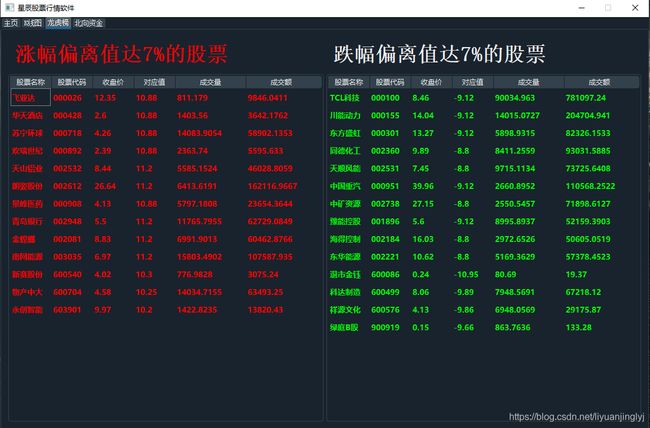python股票量化交易(14)---使用pyqt5构建股票交易龙虎榜
目录
- 获取龙虎榜数据
- pyqt5显示龙虎榜数据
获取龙虎榜数据
对于股市来说,那些涨幅跌幅都比较大的股票多是游资的聚集地,这些聚集地往往登上龙虎榜的几率非常的高。对于喜欢玩短期的散户来说,尤其喜欢通过该榜单搏一搏的投资者,尤其钟爱龙虎榜。所以,我们可以给我们的交易软件提供一个这样的榜单。
获取免费龙虎榜的方式如下:
df_rise = ak.stock_sina_lhb_detail_daily(trade_date="20210205", symbol="涨幅偏离值达7%的证券")
df_fall = ak.stock_sina_lhb_detail_daily(trade_date="20210205", symbol="跌幅偏离值达7%的证券")
第1个参数如日期,第2个参数为获取的龙虎榜类型。这里,我们的日期都是手动设置的,等我们到后面,通过判断工作日,将其替换掉就行。
pyqt5显示龙虎榜数据
首先,我们需要通过线程获取到龙虎榜的数据,具体代码如下:
import akshare as ak
from PyQt5 import QtCore
from PyQt5.QtCore import pyqtSignal
from pandas import DataFrame
class OtherThread(QtCore.QThread):
_signalRise = pyqtSignal(DataFrame)
_signalFall = pyqtSignal(DataFrame)
def __init__(self):
super(OtherThread, self).__init__()
def run(self):
df_rise = ak.stock_sina_lhb_detail_daily(trade_date="20210205", symbol="涨幅偏离值达7%的证券")
df_fall = ak.stock_sina_lhb_detail_daily(trade_date="20210205", symbol="跌幅偏离值达7%的证券")
self._signalRise.emit(df_rise)
self._signalFall.emit(df_fall)
数据获取完成之后,就可以直接显示到界面上了,main.py的代码如下所示:
class MyFrom(QMainWindow):
# 龙虎榜
def init_otherTab(self):
self.otherGrid = QGridLayout()
self.otherGrid.setSpacing(5)
ft = QFont()
ft.setPointSize(26)
ft.setBold(True)
rise_label = QLabel("涨幅偏离值达7%的股票")
rise_label.setFont(ft)
rise_label.setStyleSheet("color:red")
fall_label = QLabel("跌幅偏离值达7%的股票")
fall_label.setFont(ft)
self.otherGrid.addWidget(rise_label, 0, 0, 1, 8)
self.otherGrid.addWidget(fall_label, 0, 8, 1, 8)
self.otherTab.setLayout(self.otherGrid)
self.otherThread = OtherThread()
self.otherThread._signalRise.connect(self.otherRise_callbacklog)
self.otherThread._signalFall.connect(self.otherFall_callbacklog)
self.otherThread.start()
def otherFall_callbacklog(self, df):
ft = QFont()
ft.setPointSize(10)
ft.setBold(True)
m_color = QColor(0, 255, 0)
otherFalltableWidget = QTableWidget(len(df), 6)
otherFalltableWidget.setHorizontalHeaderLabels(['股票名称', '股票代码', '收盘价', "对应值", "成交量", "成交额"])
otherFalltableWidget.setEditTriggers(QAbstractItemView.NoEditTriggers) # 不可编辑
otherFalltableWidget.horizontalHeader().setSectionResizeMode(QHeaderView.Fixed) # 禁止拖拽
otherFalltableWidget.setSelectionBehavior(QAbstractItemView.SelectRows) # 只能选中一行
otherFalltableWidget.itemClicked.connect(self.tableWidget_connect)
otherFalltableWidget.verticalHeader().setVisible(False)
otherFalltableWidget.setShowGrid(False) # 不显示子线条
otherFalltableWidget.setColumnWidth(0, 70) # 设置第一列宽
otherFalltableWidget.setColumnWidth(1, 70) # 设置第二列宽
otherFalltableWidget.setColumnWidth(2, 70) # 设置第三列宽
otherFalltableWidget.setColumnWidth(3, 70) # 设置第三列宽
otherFalltableWidget.setColumnWidth(4, 120) # 设置第三列宽
otherFalltableWidget.setColumnWidth(5, 120) # 设置第三列宽
for idx, row in df.iterrows():
newItem0 = QTableWidgetItem(str(row["股票名称"]))
newItem0.setFont(ft)
newItem0.setForeground(QBrush(m_color))
newItem1 = QTableWidgetItem(str(row["股票代码"]))
newItem1.setFont(ft)
newItem1.setForeground(QBrush(m_color))
newItem2 = QTableWidgetItem(str(row["收盘价"]))
newItem2.setFont(ft)
newItem2.setForeground(QBrush(m_color))
newItem3 = QTableWidgetItem(str(row["对应值"]))
newItem3.setFont(ft)
newItem3.setForeground(QBrush(m_color))
newItem4 = QTableWidgetItem(str(row["成交量"]))
newItem4.setFont(ft)
newItem4.setForeground(QBrush(m_color))
newItem5 = QTableWidgetItem(str(row["成交额"]))
newItem5.setFont(ft)
newItem5.setForeground(QBrush(m_color))
otherFalltableWidget.setItem(idx, 0, newItem0)
otherFalltableWidget.setItem(idx, 1, newItem1)
otherFalltableWidget.setItem(idx, 2, newItem2)
otherFalltableWidget.setItem(idx, 3, newItem3)
otherFalltableWidget.setItem(idx, 4, newItem4)
otherFalltableWidget.setItem(idx, 5, newItem5)
self.otherGrid.addWidget(otherFalltableWidget, 1, 8, 10, 8)
def otherRise_callbacklog(self, df):
ft = QFont()
ft.setPointSize(10)
ft.setBold(True)
m_color = QColor(255, 0, 0)
otherRisetableWidget = QTableWidget(len(df), 6)
otherRisetableWidget.setHorizontalHeaderLabels(['股票名称', '股票代码', '收盘价', "对应值", "成交量", "成交额"])
otherRisetableWidget.setEditTriggers(QAbstractItemView.NoEditTriggers) # 不可编辑
otherRisetableWidget.horizontalHeader().setSectionResizeMode(QHeaderView.Fixed) # 禁止拖拽
otherRisetableWidget.setSelectionBehavior(QAbstractItemView.SelectRows) # 只能选中一行
otherRisetableWidget.itemClicked.connect(self.tableWidget_connect)
otherRisetableWidget.verticalHeader().setVisible(False)
otherRisetableWidget.setShowGrid(False) # 不显示子线条
otherRisetableWidget.setColumnWidth(0, 70) # 设置第一列宽
otherRisetableWidget.setColumnWidth(1, 70) # 设置第二列宽
otherRisetableWidget.setColumnWidth(2, 70) # 设置第三列宽
otherRisetableWidget.setColumnWidth(3, 70) # 设置第三列宽
otherRisetableWidget.setColumnWidth(4, 120) # 设置第三列宽
otherRisetableWidget.setColumnWidth(5, 120) # 设置第三列宽
for idx, row in df.iterrows():
newItem0 = QTableWidgetItem(str(row["股票名称"]))
newItem0.setFont(ft)
newItem0.setForeground(QBrush(m_color))
newItem1 = QTableWidgetItem(str(row["股票代码"]))
newItem1.setFont(ft)
newItem1.setForeground(QBrush(m_color))
newItem2 = QTableWidgetItem(str(row["收盘价"]))
newItem2.setFont(ft)
newItem2.setForeground(QBrush(m_color))
newItem3 = QTableWidgetItem(str(row["对应值"]))
newItem3.setFont(ft)
newItem3.setForeground(QBrush(m_color))
newItem4 = QTableWidgetItem(str(row["成交量"]))
newItem4.setFont(ft)
newItem4.setForeground(QBrush(m_color))
newItem5 = QTableWidgetItem(str(row["成交额"]))
newItem5.setFont(ft)
newItem5.setForeground(QBrush(m_color))
otherRisetableWidget.setItem(idx, 0, newItem0)
otherRisetableWidget.setItem(idx, 1, newItem1)
otherRisetableWidget.setItem(idx, 2, newItem2)
otherRisetableWidget.setItem(idx, 3, newItem3)
otherRisetableWidget.setItem(idx, 4, newItem4)
otherRisetableWidget.setItem(idx, 5, newItem5)
self.otherGrid.addWidget(otherRisetableWidget, 1, 0, 10, 8)
这里,博主为了偷懒,没有使用for循环生成pyqt5的控件。感兴趣的可以模仿量化交易第11篇,使用for循环生成QLabel的方式生成QTableWidgetItem。
